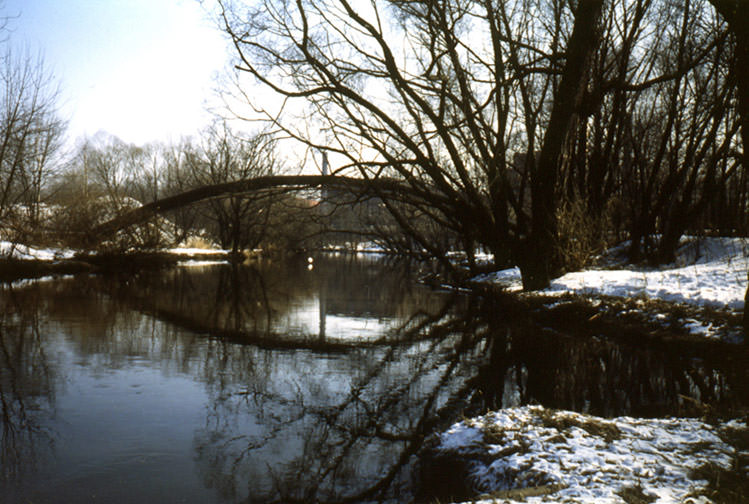KOLLEKTIVNYE DEYSTVIYA (COLLECTIVE ACTIONS). DESCRIPTIONS OF THE ACTIONS
JOURNEYS TO THE COUNTRYSIDE. VOLUME SIX
62. THE ROSETTE
S: I was very much impressed by the fact that in a shoeshop in Prospekt Mira where we dropped in was virtually empty, only lonesome rubber boots rested in a corner. In the halls there were some small shops, kiosks selling plaster decorations instead of boots. I mean, these shops were selling not necessary goods, but instead some weird ornamental stuff. In earlier times such objects could be seen only on facades or interiors of grand governmental “feudal” type buildings. And now these plaster tongues and pretzels have transformed into goods freely migrating on everyday level, more or less fitting the scale of household interiors.
A: This rosette that we’ve bought is most probably designed to be attached to the ceiling and through a hole in its center a chandelier cord can be run through. At first we had no obvious plan on what to do with the rosette. But I wanted to take a walk along Yauza’s bank and offered Sabina to entertain ourselves by hanging this rosette on the bridge over Yauza, as she didn’t feel like walking out. The day was sunny, snow was lying all around. We reached an arch-shaped iron bridge, I got to its top and hung the rosette on a rope above the water. In the meantime Sabina was taking photographs from the riverbank. The effect of the rosette that revolved under sun rays reflecting in the water was very inspiring. It was rather hard to catch it in the finder at the moment when it turned its “façade” to the lens and was shining brightly in the sun. We took several photos from various positions and departed.
S. Indeed, I feel no regret that I was so enchanted by this rosette. By the way, there also are such decorations on bridges, but they are anchored as architectural parts. At the same time this very element was somehow detached from the architectural immobility and was revolving freely, inviting to examine it from every side. Taking photographs was a constructive element of the action: it was very intriguing to catch light effects standing at different positions against the sun and the rosette on both banks of the river. From a closer distance its ornament could be distinguished, while from afar it looked like a small white point over water. The position of taking pphotographs of the rosette from the top of the bridge turned out to be psychologically aggravated. Perhaps it was due to the fear of heights mixed with the delight of watching the shining white disk under one’s feet. Curiously enough, the rosette and its reflection in the water were shaped like figure 8, and it added some comic effect to the situation, as it was the eighth of March, the International Women’s Day. But if we treat this action more seriously, it seems to me to be corresponding with the esthetical purposes of early 90s. The constructive element here is only the backround for representation of autonomous ornamental elements.
A: But the constructive layer is also important here. To me personally this action seems to be a reaction to such KD actions as “The Lantern” and “The Dark Place”. In semantical sense the associations with “The Lantern” are rather hard to be explained, although in constructive sense the action is very similar to them, and the object itself relates to “lantern-ness”, illumination. But while in “The Lantern” we exhibited the source of light itself, here the decorative element of a light source is concerned. At the same time it is distanced and drowned in “ornamentalism” so much that it decorates both the source of light and its place of mounting on the ceiling. Most probably it can be considered the expositional element in the aspect of “The Lantern” which in its turn was “downgraded” to demonstrational level.
The self-contained “splendour” as esthetical category is also of importance here. Most probably, it is demonstrated in the first place.
Moscow, river Yauza in Losiny Ostrov district.
8.3.1991
A. Monastyrski, S. Haensgen

